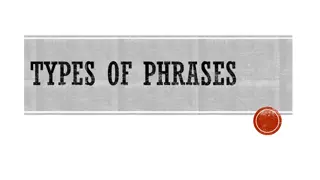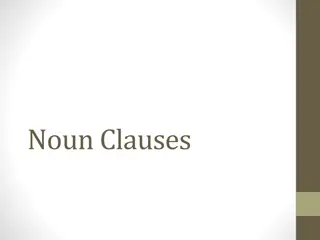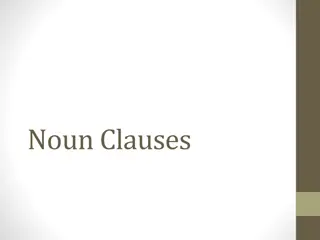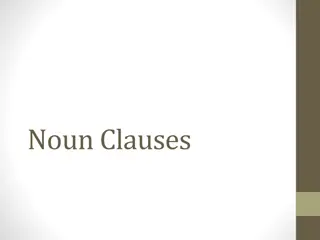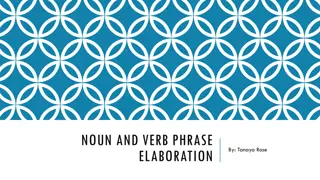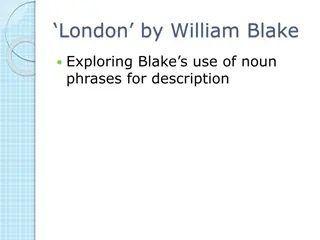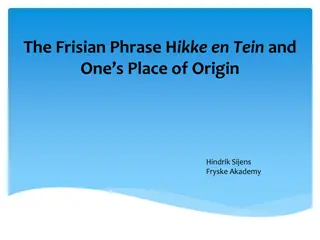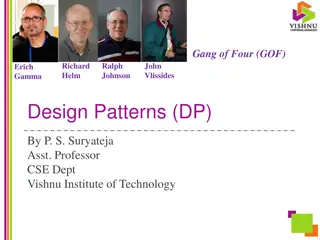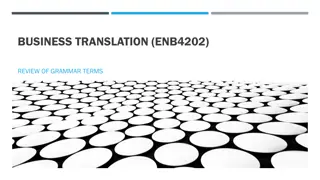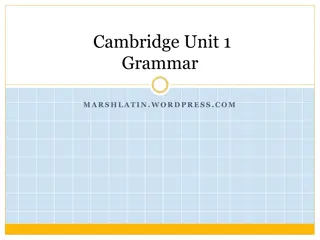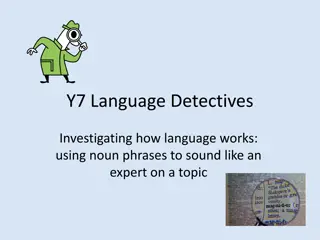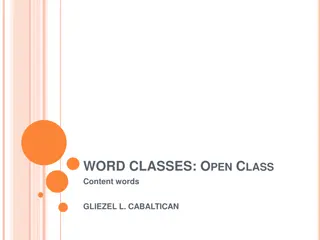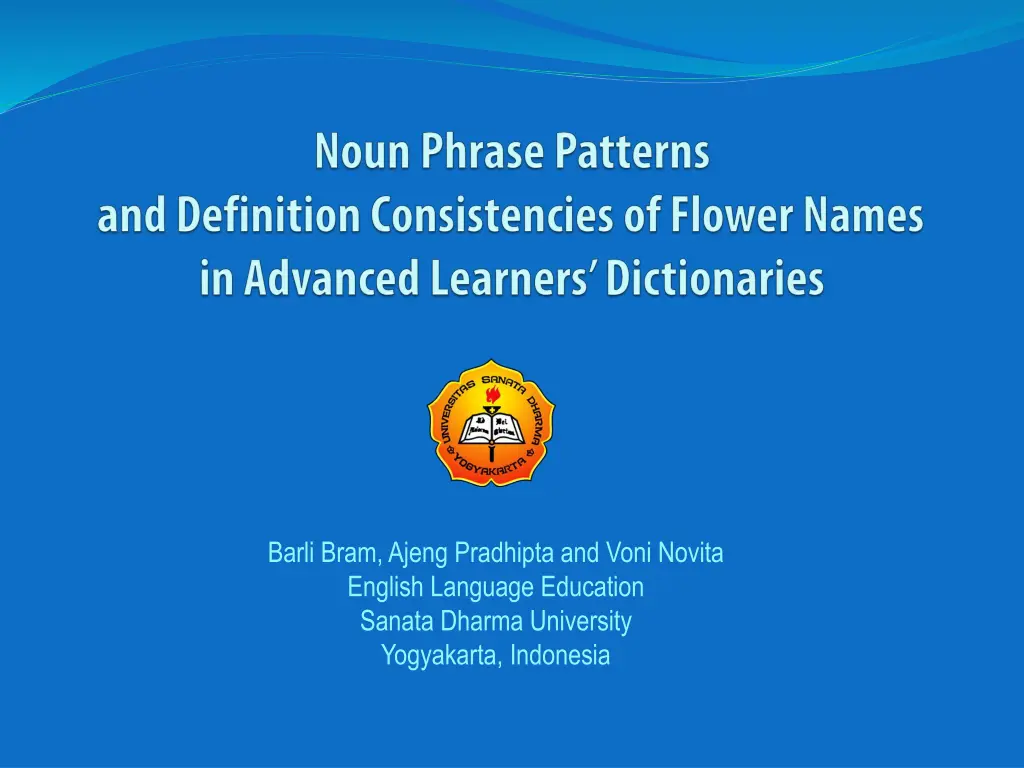
Exploring Noun Phrase Patterns and Flower Name Definitions in English Learning Context
Dive into the examination of noun phrase patterns and definition consistencies of flower names in English, analyzing complexities for learners and the use of hyponymy and hypernymy/superordinate relations in dictionary definitions.
Download Presentation

Please find below an Image/Link to download the presentation.
The content on the website is provided AS IS for your information and personal use only. It may not be sold, licensed, or shared on other websites without obtaining consent from the author. If you encounter any issues during the download, it is possible that the publisher has removed the file from their server.
You are allowed to download the files provided on this website for personal or commercial use, subject to the condition that they are used lawfully. All files are the property of their respective owners.
The content on the website is provided AS IS for your information and personal use only. It may not be sold, licensed, or shared on other websites without obtaining consent from the author.
E N D
Presentation Transcript
Barli Bram, Ajeng Pradhipta and Voni Novita English Language Education Sanata Dharma University Yogyakarta, Indonesia
hibiscus: bush, flower or plant? 2 Sanata Dharma University Yogyakarta Indonesia 2015 Pic credit: Barli Bram
Presentation Structure Introduction, Objective Review Data, Methods Results Concluding Remarks References 3 Sanata Dharma University Yogyakarta Indonesia 2015
Why NP Patterns and Flower Name Definitions? NP patterns: highly productive as subjects and objects and might be complex (for English learners) Flower name definitions in dictionaries: how consistent (in using flower as headword)? (hyponymy-hyper(o)nymy/superordinate relations) 4 Sanata Dharma University Yogyakarta Indonesia 2015
Objective to examine noun phrase patterns and definition consistencies of flower names in English provided by two online advanced learners dictionaries. (consistent = flower as headword) In the context of language learning, complex noun phrases might be problematic for English learners and the uses of hyponymy and hypernymy/superordinate in dictionary definitions may prove to be inconsistent. 5 Sanata Dharma University Yogyakarta Indonesia 2015
Review: Hyponym and Hypernym (1) In semantics, the term hyponymrefers to a word of more specific meaning than a hyper(o)nym or a superordinate term applicable to it (OALD); the noun eagle is a hyponym of bird, for example. The term hyper(o)nym or superordinaterefers to a word with broad meaning constituting a category into which words with more specific meanings fall (OALD). For instance, flower is a hyper(o)nym of tulip. 6 Sanata Dharma University Yogyakarta Indonesia 2015
Hyponym and Hypernym (2) Poole (1999: 25) Such a relationship between words whereby more specific terms are arranged under their more general superordinate terms is known as hyponymy . See the figure below: animal mammal cat dog wolf poodle terrier spaniel (Poole, 1999: 25) 7 Sanata Dharma University Yogyakarta Indonesia 2015
Hyponym and Hypernym (3) diagram of flower name hyponym-hypernym (suggestion) living being plant flower bluebell carnation rose tulip 8 Sanata Dharma University Yogyakarta Indonesia 2015
Hyponym and Hypernym (4) One of the most important structuring relations in the vocabulary of a language is hyponymy. This is the relation between apple and fruit, car and vehicle, slap and hit, and so on. We say that apple is a hyponym of fruit, and conversely, that fruit is a superordinate (occasionally hypernym) of apple (Cruse, 2000: 150). De Swart (1998: 18): hyponymy (often creating a taxonomy, also called an isa-hierarchy a German shepherd is a dog, is a mammal, is a living being; a dandelion is a flower, is a plant, is a living being . 9 Sanata Dharma University Yogyakarta Indonesia 2015
Noun Phrase (1) In syntax, phrases consist of minimally a head, and it is the syntactic category of the head that determines the category of the phrase. a phrase with a noun as head is a Noun Phrase (NP) For instance hard work is an NP with the noun workas its head (Booij, 2005: 53). A noun phrase: a phrase whose head is a noun. Thus, the expression lovers of opera is a noun phrase, since its head is the noun lovers (Radford, 1998: 518). 10 Sanata Dharma University Yogyakarta Indonesia 2015
Noun Phrase (2) A head: a word which acts as the core of a phrase and gives it its grammatical character. In the noun phrase these big books about phonetics , the noun books is the head (Swan, 2007: 111). It is customary to describe the English nominal as consisting of a sequence of constituents: predeterminers, determiners, adjectives, the noun head, and finally certain postnominal modifiers, such as relative clauses (Lees, 1961: 2). 11 Sanata Dharma University Yogyakarta Indonesia 2015
Data and Methods Forty-five (45) lexical items flower names and their definitions rom two online English-English dictionaries, namely the Oxford Advanced Learner s Dictionary (OALD) and Cambridge Advanced Learner s Dictionary (CALD). Why these two? Authoritative, reliable and accessible Collected lexical items: 45 flower definitions were examined to identify noun phrase patterns or structures used in the definitions and to discover whether or not the definitions (hyponym-hyper(o)nym relations) in the two dictionaries were consistent. 12 Sanata Dharma University Yogyakarta Indonesia 2015
Sample Screenshot from OALD (daffodil) Pic ture credit: online source 13 Sanata Dharma University Yogyakarta Indonesia 2015
Table 1: Flower Definitions from OALD (Five Examples) No Flower Definition Pre-mod Head Post-mod 1 amaryllis a tall white, pink or red flower shaped like a trumpet det+adjP flower clause 2 bluebell a garden or wild flower with a short stem and small blue or white flowers shaped like bells det+adjP flower PP 3 bougainvillea a tropical climbing plant with red, purple, white or pink flowers det+adjP plant PP 4 camellia a bush with shiny leaves and white, red or pink flowers that look like roses and are also called camellias det bush PP 5 carnation a white, pink, red or yellow flower, often worn as a decoration on formal occasions det+adjP flower clause (often) 14 Sanata Dharma University Yogyakarta Indonesia 2015
Table 2: Flower Definitions from CALD (Five Examples) No Flower Definition Pre-mod Head Post-mod 1 amaryllis Not found N/A N/A N/A 2 bluebell a small European plant that usually grows in woods and has blue flowers shaped like bells det+adjP plant clause (usually) 3 bougainvillea a climbing plant, common in hot countries, that has red or purple flowers det+adjP plant clause (appositive) 4 camellia a bush with dark, shiny leaves and large white, pink, or red flowers that are similar to roses det bush PP 5 carnation (a plant with) a small flower with a sweet smell, usually white, pink, or red in colour det plant/flower PP 15 Sanata Dharma University Yogyakarta Indonesia 2015
Results: Headwords in OALD and CALD OALD & CALD Headwords 30 25 20 15 10 5 0 bush bush/plant bush/tree flower flower/plant plant N/A OALD CALD 16 Sanata Dharma University Yogyakarta Indonesia 2015
Headword Percentages (OALD) OALD Headwords bush 7% bush/plant 5% bush/tree 4% flower 24% plant 58% flower/plant 2% bush bush/plant bush/tree flower flower/plant plant 17 Sanata Dharma University Yogyakarta Indonesia 2015
Headword Percentages (CALD) CALD Headwords bush 7% N/A 9% bush/plant 2% bush/tree 5% flower 13% flower/plant 2% plant 62% bush bush/plant bush/tree flower flower/plant plant N/A 18 Sanata Dharma University Yogyakarta Indonesia 2015
Pre-modifiers in OALD and CALD OALD & CALD Pre-modifiers 40 35 30 25 20 15 10 5 0 det det+adjP det+PP N/A OALD CALD 19 Sanata Dharma University Yogyakarta Indonesia 2015
Pre-modifier Percentages (OALD) OALD Pre-modifiers det 20% det+adjP 80% det det+adjP 20 Sanata Dharma University Yogyakarta Indonesia 2015
Pre-modifier Percentages (CALD) CALD Post-modifiers N/A 9% det+PP 4% det 27% det+adjP 60% det det+adjP det+PP N/A 21 Sanata Dharma University Yogyakarta Indonesia 2015
Post-modifiers in OALD and CALD OALD & CALD Post-modifiers 40 35 30 25 20 15 10 5 0 adj clause adj phrase PP no post-mod N/A OALD CALD 22 Sanata Dharma University Yogyakarta Indonesia 2015
Post-modifier Percentages (OALD) OALD Post-modifiers no post-mod 2% adj clause 20% PP 78% adj clause PP no post-mod 23 Sanata Dharma University Yogyakarta Indonesia 2015
Post-modifier Percentages (CALD) CALD Post-modifiers N/A 9% no post-mod 2% adj clause 29% adj phrase 2% PP 58% adj clause adj phrase PP no post-mod N/A 24 Sanata Dharma University Yogyakarta Indonesia 2015
Concluding Remarks 1) the basic noun phrase pattern: premodifier+headword+(postmodifier) and 2) inconsistencies in the definitions (flower not as head) Study results: would assist learners of the English language to understand better the patterns and definitions of flower names which will then improve the learners noun phrase mastery and semantic knowledge, particularly hyponymy and hypernymy/superordinate. 25 Sanata Dharma University Yogyakarta Indonesia 2015
References (partial list) Aitchison, Jean. 1999. Teach Yourself: Linguistics. London: Hodder & Stoughton. Bauer, Laurie. 2007. The Linguistics Student's Handbook. Edinburgh: Edinburgh University Press. Booij, Geert. 2005. The Grammar of Words. Oxford: Oxford University Press. Caraballo, Sharon. (1999, June). Automatic construction of a hypernym-labeled noun hierarchy from text. In Proceedings of the 37th annual meeting of the Association for Computational Linguistics on Computational Linguistics (pp. 120-126). Association for Computational Linguistics. Culo, Oliver, Katrin Erk, Sebastian Pado and Sabine Schulte. 2008. Comparing and Combining Semantic Verb Classifications. In Language Resources and Evaluation (vol. 42, no. 3, pp. 265-291). http://www.jstor.org/stable/41217880. Accessed: 05-07-2015 05:09 UTC. Goddard, Cliff. 1998. Semantic Analysis: A Practical Introduction. Oxford: Oxford University Press. Gregory, Howard. 2000. Semantics: Language Workbooks. New York: Routledge. Guthrie, Louise, Brian M. Slator, Yorick Wilks, and Rebecca Bruce. "Is there content in empty heads?. In Proceedings of the 13th conference on Computational linguistics-Volume 3, pp. 138-143. Association for Computational Linguistics, 1990. Retrieved 12 July 2015. http://citeseerx.ist.psu.edu/viewdoc/download?doi=10.1.1.34.946&rep=rep1&type=pdf Huang, Zhiheng, Thint, Marcus and Qin Zengchang. 2008. Question Classification Using Head Words and Their Hypernyms. In Proceedings of the 2008 Conference on Empirical Methods in Natural Language Processing, pp 927 936, Honolulu. Retrieved 12 July 2015. http://delivery.acm.org/10.1145/1620000/1613835/p927-huang.pdf Hurford, James, Brendan Heasley and Michael Smith. 2007. Semantics: A Coursebook. Cambridge: Cambridge University Press. Leech, Geoffrey. 1974. Semantics. Middlesex: Pelican Books. Lees, R.B. 1961. The Constituent Structure of Noun Phrases. In American Speech (vol. 36, no. 3, pp. 159-168). http://www.jstor.org/stable/453514. Accessed: 05-07-2015. Lyons, John. 1977. Semantics: 2. Cambridge: Cambridge University Press. Lyons, John. 1995. Linguistic Semantics: An Introduction. Cambridge: Cambridge University Press. Matthews, Peter.1997. Concise Dictionary of Linguistics. Oxford: Oxford University Press. Poole, Stuart. 1999. An Introduction to Lingustics. New York: St. Martin s Press. Quirk, Randolph, Sidney Greenbaum, Geoffrey Leech and Jan Svartvik. 1986. A Comprehensive Grammar of the English Language. London: Longman. Radford, Andrew. 1997. Syntax: A Minimalist Introduction. Cambridge: Cambridge University Press. Radford, Andrew. 2001. English Words: History and Structure. Cambridge: Cambridge University Press. ... 26 Sanata Dharma University Yogyakarta Indonesia 2015

